By James Stevens Curl
This book is Volume 22 of the major project to record public sculpture throughout Britain, and is a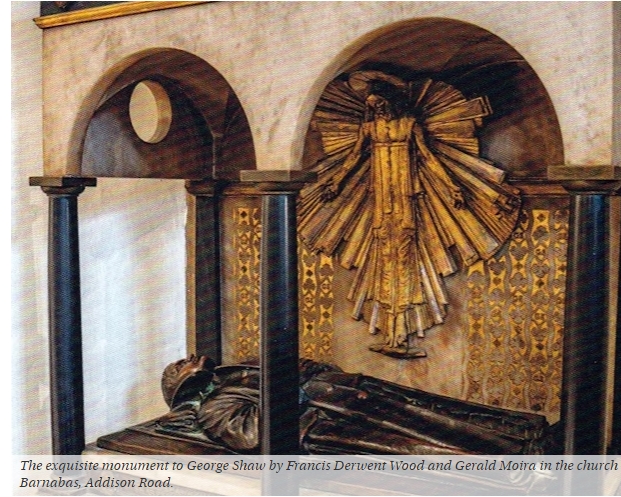 triumph. Designed and produced by Richard Barnes, copy-edited by Joanna Barnes and Mark Stocker, with an admirable Foreword by the late, great Lord Cormack (a true Conservative and genuine Churchman of the Old School), it was happily originated, printed, and bound in Sussex, and not farmed out to China, a tendency to which far too many unwise and short-sighted publishing outfits are prone, to the detriment of our own excellent firms and craftsmen. Publication is more than timely, when baying mobs and their cowardly apologists and fellow-travellers are intent on tearing down statues erected to individuals deemed unworthy of respect. As Patrick Cormack wisely observed, “in the whole of human history no human being has ever been perfect and without fault”. Amen to that.
triumph. Designed and produced by Richard Barnes, copy-edited by Joanna Barnes and Mark Stocker, with an admirable Foreword by the late, great Lord Cormack (a true Conservative and genuine Churchman of the Old School), it was happily originated, printed, and bound in Sussex, and not farmed out to China, a tendency to which far too many unwise and short-sighted publishing outfits are prone, to the detriment of our own excellent firms and craftsmen. Publication is more than timely, when baying mobs and their cowardly apologists and fellow-travellers are intent on tearing down statues erected to individuals deemed unworthy of respect. As Patrick Cormack wisely observed, “in the whole of human history no human being has ever been perfect and without fault”. Amen to that.
The area of London covered by this excellent book possesses an astonishingly rich legacy of sculpture, including, as it does, “Albertopolis”, which evolved from the historical imagination of that enlightened, high-minded German Prince, the finest, greatest King we never had. The monument (1863) to Prince Albert’s huge achievement, the Great Exhibition of 1851, in Prince Consort Road, designed by Sydney Smirke with sculpture by Joseph Durham, is really a very noble thing, standing proudly to the south of the Royal Albert Hall: it deserves close scrutiny, for there is much to admire in its details and the materials with which it is made.
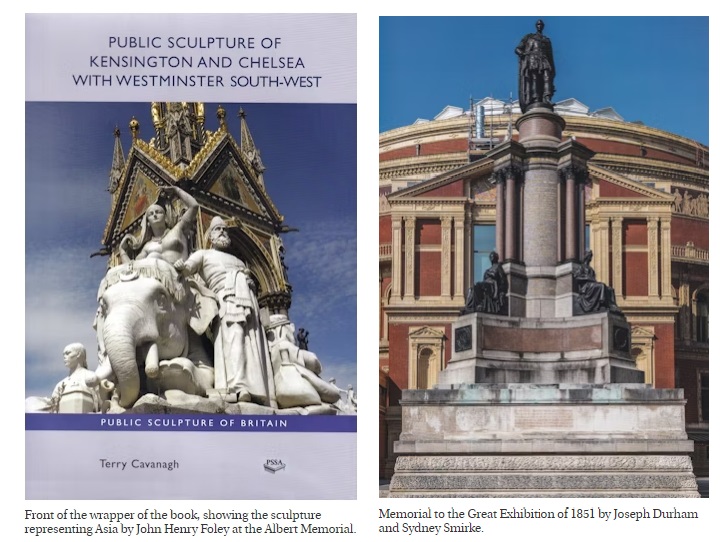
Albert’s glorious Memorial (1863-76), the shrine-like design of George Gilbert “Great” Scott, was embellished with marvellous sculpture by H.H. Armstead, John Bell, William Brindley, J.H. Foley, John Lawlor, Patrick MacDowell, W.C. Marshall, J.Birnie Philip, J. Redfern, W. Theed the Younger, T. Thornycroft, and Henry Weekes, but further individuals were involved, including F.W. Shields, F.A. Skidmore, J.R. Clayton, John Kelk, and many others. The coverage of Scott’s great edifice in this splendid production is thorough and immensely detailed, with good illustrations, and fills pp. 399 to 440. However, it should be remembered that in 1983 the Albert Memorial was threatened with demolition: it was saved when the Victorian Society et al. ensured funding for a complete refurbishment of that breathtaking work.
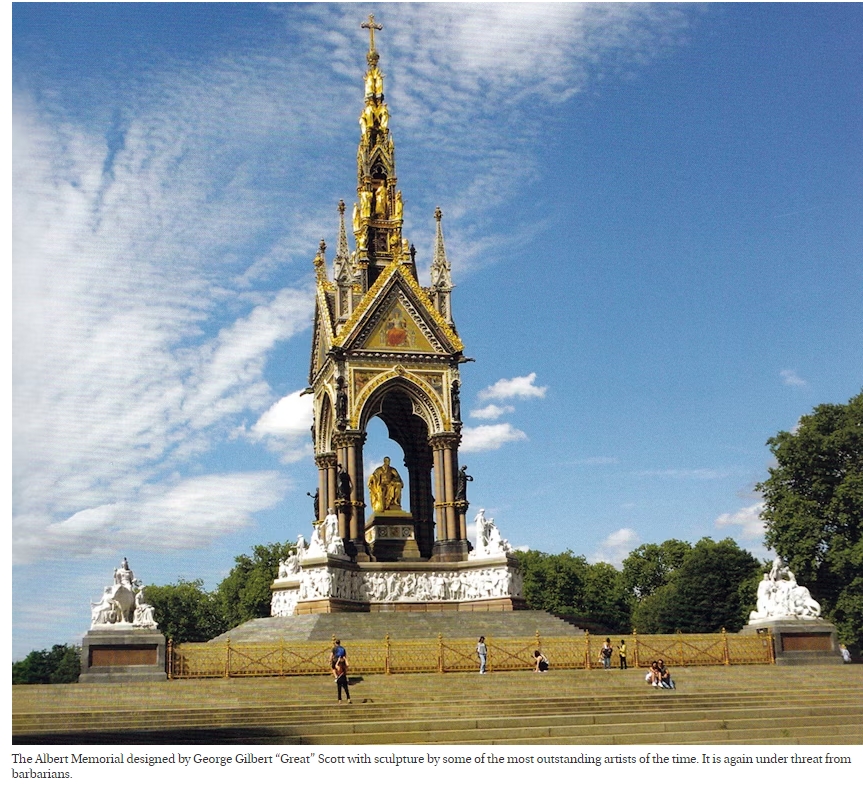
New dangers loom now, as some individuals connected with the Royal Parks claim that aspects of the sculpture are deemed “offensive”, reflecting a “Victorian view of the world”. Those who wish to destroy monuments should reflect that it was not long ago when the Albert Memorial was sneered at, abused, dismissed, insulted, and endangered by that enemy of Reason, Received Opinion, all widely accepted by those who only look with their ears. It is actually a thing of great beauty, crafted exquisitely, stuffed with allusions and meaning, all of which should become apparent to any reasonable observer capable of looking at it and its details with a clear-sighted eye and an unclouded brain. What I find deeply offensive and troubling is the kind of iconoclastic zeal that prompts the destruction of anything that might incur the displeasure, for whatever reason, of self-appointed wreckers, always sniffing out heresies and taking offence at the sight of the most innocent decorations, and mouthing dark gnomic aphorisms, the sure sign of reforming quackery. They are all the same, those supposedly “caring” impostors, those humourless puritans unduly preoccupied with the morals of other mortals, and they are in the ascendant yet again, those dwellers in the twilit realm of abstractions and obfuscation where there is no place for clean thinking.
Many years ago, when working on the Northern Kensington volume for the Survey of London (1970-73), I had a good look at all the churches in the area covered by that tome, one of which was Lewis Vulliamy’s church of St Barnabas, Addison Road, in which Rodney Hubbuck and I found the lovely monument to George Shaw by Francis Derwent Wood and Gerald Moira, here given due attention, which is very pleasing. The cemeteries, too, which of course I know very well, provide much fodder for Cavanagh, who admirably includes every piece of sculpture worth mentioning, not least the wonderful monument to Frederick Leyland by Edward Burne-Jones in the West of London and Westminster Cemetery at Brompton, a glorious thing based on the kind of mediæval reliquary chasses one finds in Northern France, but embellished with delightful, flowing, bluebell decorations of metal set in the stone. Cavanagh also illustrates and describes the monument to Emmeline Pankhurst, by Eva Dorothy Allan, who changed her name to Julian Phelps Allan, as well as other less distinguished work in Brompton Cemetery.
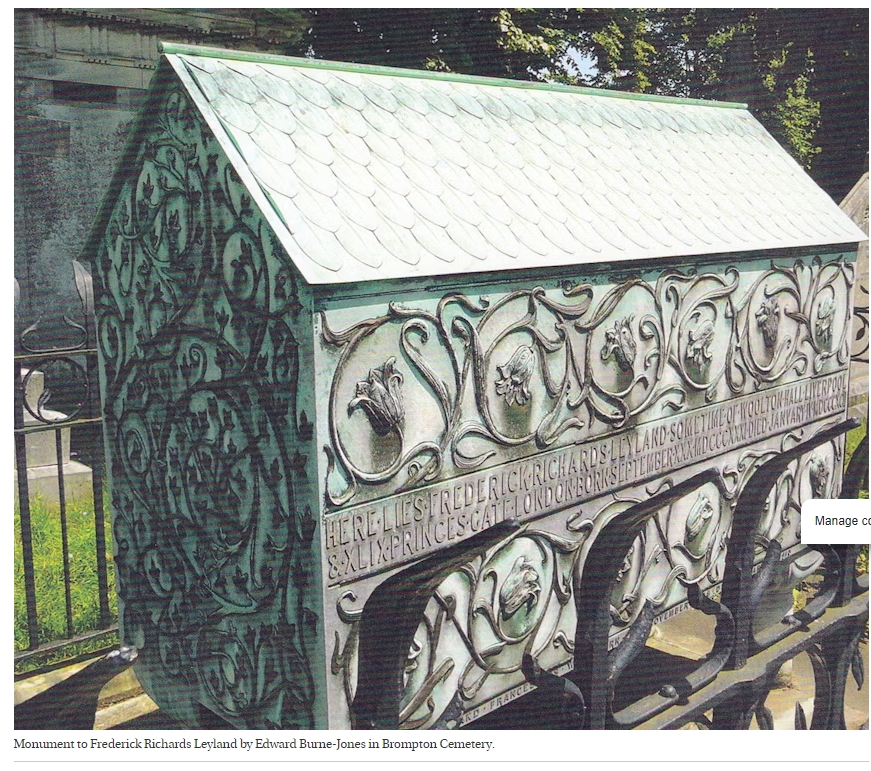
 The General Cemetery of All Souls at Kensal Green also provides Cavanagh with material, although he gets the name of the architect of the Greek Revival cemetery buildings wrong: it was not J.W. Griffith, but John Griffith of Finsbury who designed them. This error is all the more surprising as he frequently cites the major study, Kensal Green Cemetery: The Origins & Development of the General Cemetery of All Souls, Kensal Green, London, 1824-2001, which I edited and published in 2001. As for the sculpture in the cemetery, Cavanagh includes everything worthy of notice, not least the beautiful monument to Nino Michaelis (née Rydon) by Pegram, a really moving and exquisite thing (which at first glance looks as though it has strayed from a Continental cemetery), and the cenotaph of Major-General Sir William Casement by Edward Manuel Lander, with its canopy carried on telamons clad to emphasise the Eastern connection.
The General Cemetery of All Souls at Kensal Green also provides Cavanagh with material, although he gets the name of the architect of the Greek Revival cemetery buildings wrong: it was not J.W. Griffith, but John Griffith of Finsbury who designed them. This error is all the more surprising as he frequently cites the major study, Kensal Green Cemetery: The Origins & Development of the General Cemetery of All Souls, Kensal Green, London, 1824-2001, which I edited and published in 2001. As for the sculpture in the cemetery, Cavanagh includes everything worthy of notice, not least the beautiful monument to Nino Michaelis (née Rydon) by Pegram, a really moving and exquisite thing (which at first glance looks as though it has strayed from a Continental cemetery), and the cenotaph of Major-General Sir William Casement by Edward Manuel Lander, with its canopy carried on telamons clad to emphasise the Eastern connection.
The book documents many church monuments of note, not least in St Mary Abbots, where memorials were reinstated when the present building (by “Great” Scott) replaced the earlier mediæval church in 1868-72: among them is a handsome work by F.L. Chantrey to Thomas Rennell (1828) and a kneeling angel by Princess Louise, Duchess of Argyll, commemorating Alfred, Duke of Edinburgh & Saxe-Coburg, and Leopold, Duke of Albany, of 1900. This angel is very similar to another, commemorating Thomas Baring, in St Mary’s, Micheldever, Hampshire, by Joseph Edgar Boehm, whose close connection with Princess Louise is documented by Mark Stocker and others.
In Sedding’s Holy Trinity, Sloane Street, are some marvellous things by Harry Bates, F.W. Pomeroy, H.H. Armstead, and Henry Wilson, and in All Saints (“Chelsea Old Church”), are some monuments from earlier times attributed to Gerard Johnson I, William Wright, and P.V. Bernini. Particularly enjoyable is the monument to G.F. Bodley in Holy Trinity, Prince Consort Road, a charming Jacobean Revival ædicule designed by E.P. Warren sheltering a bust of the architect by Thomas Murphy Jr., clearly intended to allude to Bodley’s ancestor, the founder of the Bodleian Library, Oxford.
In this airy church Bodley was responsible for the reredos and altar-frontal as well as the pulpit, both carved by L.A. Turner and made by Rattee & Kett of Cambridge. And of course there are the vigorous 17th-century Baroque Apostles by Mazzuoli in Gribble’s great church known as Brompton Oratory: these were intended for Siena Cathedral, but by the 1890s their animated vigour was no longer regarded as appropriate for that building’s interior. Indeed, the then director of Siena’s Academy of Fine Arts suggested that the figures were only waiting for the music to strike up before they would start interweaving in a contredanse. Regarded as of “no artistic value”, these statues were removed to a warehouse in Genoa, and discovered therein by Father Charles Bowden in 1895, who negotiated their purchase in order to embellish the gloriously Roman interior of the church. I am not sure about the figure of Newman that stands in an ædicule outside the Oratory in the Brompton Road. though: by L-J Chavalliaud, it is rather a miserable thing.
Turner and made by Rattee & Kett of Cambridge. And of course there are the vigorous 17th-century Baroque Apostles by Mazzuoli in Gribble’s great church known as Brompton Oratory: these were intended for Siena Cathedral, but by the 1890s their animated vigour was no longer regarded as appropriate for that building’s interior. Indeed, the then director of Siena’s Academy of Fine Arts suggested that the figures were only waiting for the music to strike up before they would start interweaving in a contredanse. Regarded as of “no artistic value”, these statues were removed to a warehouse in Genoa, and discovered therein by Father Charles Bowden in 1895, who negotiated their purchase in order to embellish the gloriously Roman interior of the church. I am not sure about the figure of Newman that stands in an ædicule outside the Oratory in the Brompton Road. though: by L-J Chavalliaud, it is rather a miserable thing.
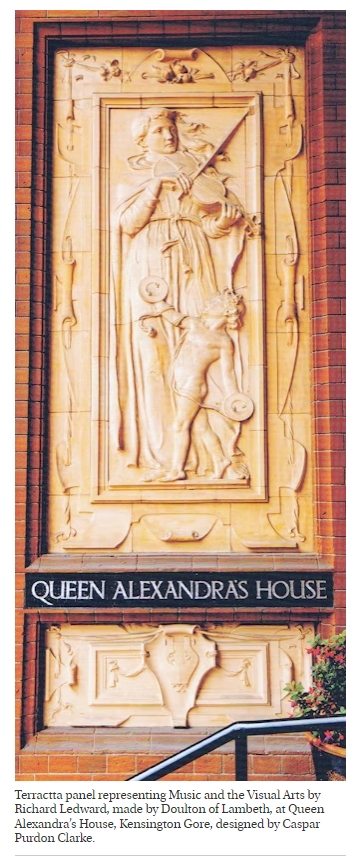
The riches in this book almost overwhelm, and only a few outstanding exemplars can be mentioned in a short review: however, there are some delights that stick in the mind, including the relief panels on that delectable building, the former Royal College of Organists, in Kensington Gore, designed by F.W. Moody and made by students of the National Art Training School, although the photograph has horrible converging verticals, and should have been rejected for that reason. There are also agreeable decorations at Queen Alexandra’s House, also in Kensington Gore, a fine building designed by C.P. Clarke, sculpted by Richard Ledward: I admired them half a century ago, and still do.
With regard to individual commemorative statuary, there is much of it in this book, but there are some examples that to my eye are duds. Princess Louise’s statue of her mother, Queen Victoria (1893), in Kensington Gardens, compares very unfavourably with Boehm’s statue of the Queen, a noble work (1889), now in the entrance-lobby of Imperial College.
The swashbuckling William III by Heinrich Baucke (cast, incidentally, by H. Gladenbeck & Sohn, Berlin-Friedrichshagen, of 1907, a gift from Kaiser Wilhelm II, German Emperor and King of Prussia, to King Edward VII for the British Nation), works well, and has a presence, a scale, a slight overstatement, which are essential ingredients in public commemorative sculpture. It might be suggested that such strengths would appear to be somewhat absent in the group (2021) commemorating Diana, Princess of Wales, by I. Rank-Broadley, which seems, to my eye, to be drippily sentimental.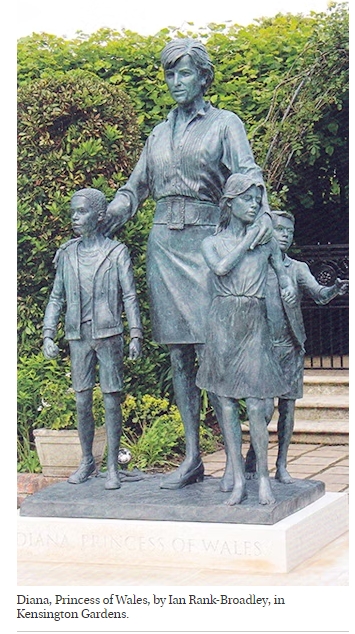 .
.
I was, moreover, never really sure about the work of G.F. Watts: the whole ensemble in Compton, Surrey, gives me the creeps, and his Physical Energy (1907) in Kensington Gardens has always looked very odd to me, especially the rear legs of the horse. Rather better is Watts’s statue of Lord Holland, in Holland Park (1871), a work to which Boehm made a considerable contribution, which might explain why it succeeds so well.
Among the more powerful individual free-standing statues which actually work extremely well, and can be regarded as successful, may be cited Westmacott’s superb “Achilles” (1822) in Hyde Park, which is actually a memorial to the Duke of Wellington; Leonid Molodozhanyn’s dignified and powerful St Volodymyr of Ukraine in Holland Park Avenue (1988—cast in Winhöring, Germany); and Boehm’s equestrian statue (1891) in Queen’s Gate commemorating Field Marshal Lord Napier of Magdala. This last was once proposed for the vacant plinth in Trafalgar Square, where it would have been far more appropriate than some of the banal and vulgar stuff inflicted on that unfortunate site in recent times. 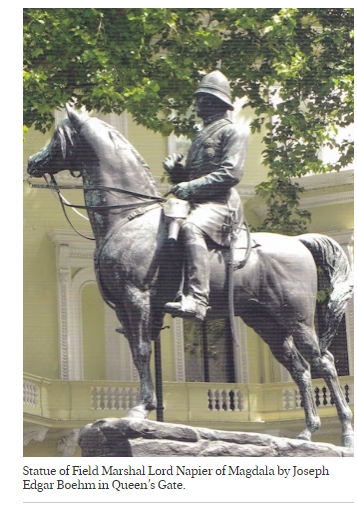
This wonderful book is crammed with records of statuary and other decorations all integral parts of the architecture of buildings, rather than stuck on as an afterthought, which is the usual case with Modernism. And the trouble with abstraction is that if you abstract too much it becomes meaningless, which is the case with some of the sculpture erected in recent decades: Hepworth’s River Form is recorded as among “Lost and Removed Works”, while Wragg’s Embrace (1966), formerly in King’s Road, Chelsea (where it was subjected to repeated vandalism), was relocated to Milton Keynes.
There have also been many losses due to demolition of the buildings certain sculptures once adorned: one example is the disappearance of Kensington Town Hall (demolished 1982), formerly a rich store of Victorian work. The sculpture, Innocent 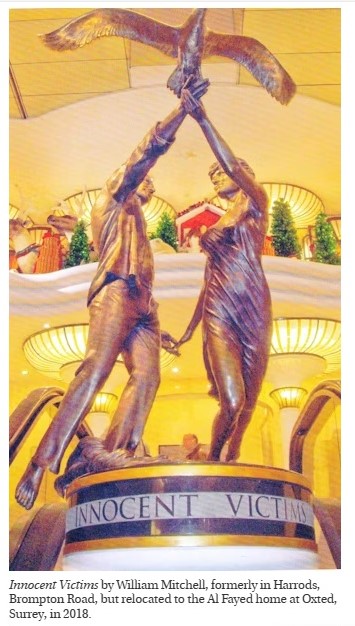 Victims (2005), by William Mitchell, showing Dodi Al Fayed and Diana, Princess of Wales, dancing, while releasing an albatross, which formerly stood between the Egyptian escalators in Harrods, was removed and returned to Mohamed Al Fayed by the new owners of Harrods, Qatari Holdings. While hugely popular with certain sections of the public, there is no doubt the work fell perilously near, or even into, the category of Kitsch, and it was certainly in very dubious taste. Cavanagh includes it, with a photograph, nevertheless, in the section on “Lost and Removed Works”, and he was absolutely right to do so.
Victims (2005), by William Mitchell, showing Dodi Al Fayed and Diana, Princess of Wales, dancing, while releasing an albatross, which formerly stood between the Egyptian escalators in Harrods, was removed and returned to Mohamed Al Fayed by the new owners of Harrods, Qatari Holdings. While hugely popular with certain sections of the public, there is no doubt the work fell perilously near, or even into, the category of Kitsch, and it was certainly in very dubious taste. Cavanagh includes it, with a photograph, nevertheless, in the section on “Lost and Removed Works”, and he was absolutely right to do so.
One of the more amusing structures decorated with sculpture is the triumphal archway with quadriga, cartyatids, and eagles by F. Joubert, at The Pheasantry, 152 King’s Road, although the quadriga has always struck me as somewhat undersized for its position on top of the confection.
All in all, this book is a treasure-trove, beautifully illustrated and comprehensively researched, a marvellous record of what ought to be appreciated by everybody. One has the sense that no stone has been left unturned, and not a square metre has been left unvisited in order to catalogue this stupendous collection of art, some great, some mediocre, some dodgy, and some downright embarrassing, but all worth seeing.
All concerned with the publication of this great book deserve our gratitude and admiration.
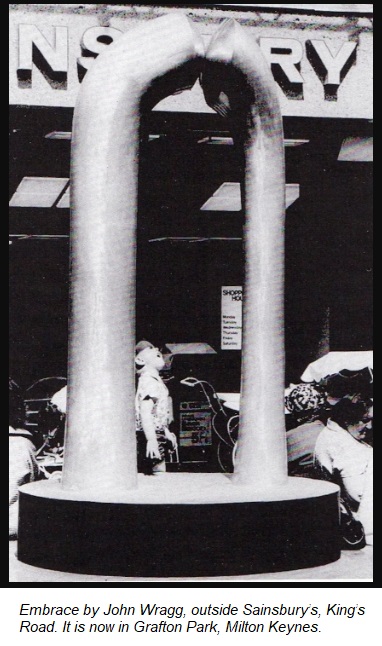
First published in The Critic
Public Sculpture of Kensington and Chelsea with Westminster South-West
by Terry Cavanagh
(Watford: Public Statues and Sculpture Association, 2023)
ISBN: 978-1-8383976-1-6 (hardback)
978-1-8383976-2-3 (softback)
xlviii + 520 pp., very many b&w and col. illus.
£35.00/£85.00
- Like
- Digg
- Del
- Tumblr
- VKontakte
- Buffer
- Love This
- Odnoklassniki
- Meneame
- Blogger
- Amazon
- Yahoo Mail
- Gmail
- AOL
- Newsvine
- HackerNews
- Evernote
- MySpace
- Mail.ru
- Viadeo
- Line
- Comments
- Yummly
- SMS
- Viber
- Telegram
- Subscribe
- Skype
- Facebook Messenger
- Kakao
- LiveJournal
- Yammer
- Edgar
- Fintel
- Mix
- Instapaper
- Copy Link






